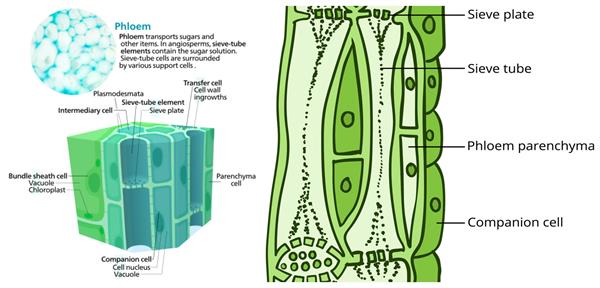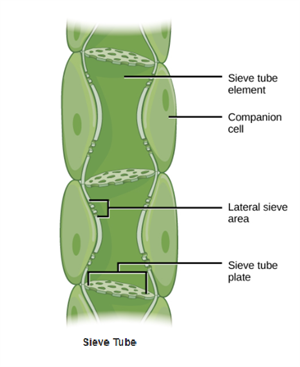PDF chapter test TRY NOW
- The term phloem was introduced by C. Nageli (1858).
- The word "phloem" is extracted from the Greek, meaning "bark".
- Phloem is the other complex tissue system in the plants.
- It is the food conducting tissues of the vascular plant. The materials (food), i.e. (towards the root and stem), can move in both directions (Bidirectional) because phloem transports food and water from leaves to all plant parts.
- All phloem cells are living except phloem fibres.
- The phloem is heterogeneous (complex tissues). It is a permanent tissue composed of different elements: Sieve elements, companion cells, phloem fibres and phloem parenchyma.

Phloem cells
Sieve elements: Conducting elements of phloem are collectively called Sieve elements.
They are of two types
- Less specialised sieve cells
- More specialised sieve tubes
These are the channels of conduction of food materials in phloem.

Sieve tube
Sieve tubes:
- They are predominantly found in angiosperms.
- These are elongated, slender tubular cells with perforated walls (small pores in the wall) placed end to end.
- The transverse walls at the ends are perforated and are called sieve plates.
- Sieve tubes are an advanced type of conducting structures in phloem.
- The lack of nuclei and organelles enables a maximum amount of translocation.
Function: The sieve tubes primary function is a translocation of food from leaves to the plants' storage organs.
Companion cells:
- They are only found in Angiosperms.
- These are living, small elongated, parenchymatous cells with thin cell walls attached to the sieve tubes' lateral wall.
- The sieve tubes and companion cells are sister cells because they originate from the same mother cell. They function together for the translocation of food.
Phloem parenchyma:
- These are present in dicotroots, leaves, and stems but are absent in monocot plants.
- These are thin-walled living cells filled with cytoplasm and a nucleus.
Function:
- It helps store food material.
- It helps to transport organic nutrients from the leaves to the parts of the plant body.
Phloem fibres:
- These are thick-walled sclerenchymatous (dead) cells associated with primary and secondary phloem.
- It is also called Bast fibre or skin fibre.
Function: It provides mechanical strength to the tissue.
Reference:
https://commons.wikimedia.org/wiki/File:Phloem_cells.svg
https://commons.wikimedia.org/wiki/File:Figure_30_05_06.jpg
